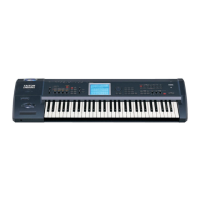4
0–2: Arpeggio
Arpeggiator parameters are edited in P7: Edit-Arpeggiator,
but major parameters can be edited here as well. When you
are playing in Program P0: Play, you can edit the arpeggia-
tor in realtime, such as changing the arpeggio pattern etc.
To write (save) the results of your editing, use “Write Pro-
gram” or “Update Program.” You can also use the [TEMPO],
[GATE], and [VELOCITY] knobs to edit the arpeggio in real-
time (☞QS p.5).
0–2a: Arpeggiator
Pat (Pattern) [P000...P004, U000(A/B)...U506(User)]
Octave [1, 2, 3, 4]
Reso (Resolution) [ , , , , , ]
Sort [Off, On]
Latch [Off, On]
Key Sync. [Off, On]
Keyboard [Off, On]
Make settings for the program arpeggiator (☞P7: Edit-
Arpeggiator).
These parameters can also be set from P7: Edit-Arpeg-
giator.
0–3: Sampling
Here you can adjust the settings for the analog/digital audio
signal input (AUDIO INPUT, S/P DIF), and the settings
related to sampling in Program mode.
You can sample either an external audio signal, or a perfor-
mance played on the TRITON Extreme. The TRITON
Extreme can also be used as a 4-in 6-out effect processor.
When sampling in Program mode, you can listen to the per-
formance of the TRITON Extreme’s arpeggiator etc. while
only sampling the external audio signal via the AUDIO
INPUT jacks or S/P DIF jacks; or you can resample while
you play a program using the TRITON Extreme’s filters,
effects, and arpeggiator. You can also mix a performance on
the TRITON Extreme together with an external audio signal,
and sample the result. (☞QS p.22, OG p.80)
“Resampling” refers to the process of sampling the
output of the TRITON Extreme. This technique allows
you to record a multi-timbral performance using multi-
ple effects and knob tweaks - whether played live, by
the arpeggiator, or by the sequencer - as a sample.
0–3a: Input (COMBI, PROG, SEQ, S.PLAY, MEDIA)
Input [Analog, S/P DIF]
Input1:
Input2:
Level [0...127]
Pan [L000...C064...R127]
BUS(IFX/Indiv.) Select
[L/R, IFX1…5, 1, 2, 3(Tube), 4(Tube), 1/2, 3/4(Tube), Off]
Send1(MFX1), Send2(MFX2) [000...127]
Here you can specify the input source analog/digital audio
device, and set the input level, pan, bus, and master effect
sends.
These Input settings are valid in Combination, Program,
Sequencer, Song Play, and Media modes. (☞Global P0:
0–3a)
0–3b: Sampling Setup
Source BUS [L/R, Indiv.1/2]
Selects the source that you want to sample. The sound being
sent to the bus selected here will be sampled.
L/R: The sound sent to the L/R bus will be sampled.
This lets you sample an external audio signal sent to the L/R
bus (specified by “Input” 0–3a), or the sounds sent to the L/
R bus from a performance played on the TRITON Extreme
from its keyboard or via MIDI input.
Indiv. 1/2: The sound sent to the INDIVIDUAL 1, 2, 1/2
buses will be sampled.
0–1
0–1a
0–2a
0–3
0–3a
0–3b
0–3c

